What is the role of astrocyte calcium in neurophysiology?
- PMID: 18817732
- PMCID: PMC3623689
- DOI: 10.1016/j.neuron.2008.09.004
What is the role of astrocyte calcium in neurophysiology?
Abstract
Astrocytes comprise approximately half of the volume of the adult mammalian brain and are the primary neuronal structural and trophic supportive elements. Astrocytes are organized into distinct nonoverlapping domains and extend elaborate and dense fine processes that interact intimately with synapses and cerebrovasculature. The recognition in the mid 1990s that astrocytes undergo elevations in intracellular calcium concentration following activation of G protein-coupled receptors by synaptically released neurotransmitters demonstrated not only that astrocytes display a form of excitability but also that astrocytes may be active participants in brain information processing. The roles that astrocytic calcium elevations play in neurophysiology and especially in modulation of neuronal activity have been intensely researched in recent years. This review will summarize the current understanding of the function of astrocytic calcium signaling in neurophysiological processes and discuss areas where the role of astrocytes remains controversial and will therefore benefit from further study.
Figures




References
-
- Anderson CM, Swanson RA. Astrocyte glutamate transport: review of properties, regulation, and physiological functions. Glia. 2000;32:1–14. - PubMed
Publication types
MeSH terms
Substances
Grants and funding
LinkOut - more resources
Full Text Sources

